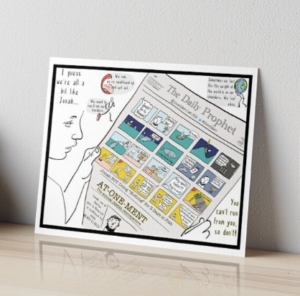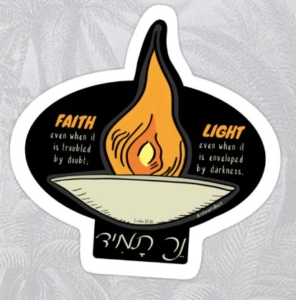VisualTorah

 Remember taking notes in school? Success meant writing down everything as fast as possible, then remembering all of it for exams. Cramming for exams was hard and usually didn’t work. Most of us remember the surface level of information, not the deep learnings.
Remember taking notes in school? Success meant writing down everything as fast as possible, then remembering all of it for exams. Cramming for exams was hard and usually didn’t work. Most of us remember the surface level of information, not the deep learnings.
But what if there were a way to quickly capture and organize ideas that produces a roadmap to all of the information stored in the subconscious? What if this same tool could be used to listen differently, to be present, and to learn to build deep understanding?
Enter sketchnoting. Though forms of visual note taking have been around for years, Mike Rohde coined the phrase ‘sketchnoting’ as a way to talk about the workflow of drawing ideas. The key to sketchnoting is that it’s about ideas, not art.
Builder Steve Silbert been sketchnoting since 2015 and uses it for work, for teaching and sharing, and for studying Torah. He writes:
I have friends who take their sketchpads, pens, and iPads into their churches to make sketchnotes of their clergy’s sermons to capture and share deep messages within their spiritual practices. I do not feel comfortable doing that in a synagogue on Shabbat, but wanted to explore deeper meaning in Torah. So I went to the URJ website and began sketchnoting divrei Torah written by rabbis for each Torah portion. Near the end of my first year of doing this I began sketching essays written by the good people at Bayit, which lead to a second Torah cycle of VisualTorah sketchnotes. (Stay tuned for A Year of Building Torah, forthcoming from Bayit, which will collect those sketchnotes and essays in print form.)
What’s different about sketchnoting Jewishly? Our sacred texts are more than simple story books. Each word can have a hundred interpretations. This means there’s an unlimited number of learnings in each Torah portion. And since there’s so much imagery in Torah verses, drawing the concepts not only helps to clarify the deep learnings but also helps the sketchnoter to remember the different layers of the story. You can see examples of VisualTorah on Builders’ Blog, or follow @SteveSilbert on Twitter or Instagram.
During 5780 (my third year of VisualTorah) I began by challenging myself to take a Torah portion and come up with a simple image to show a learning that arises from a single verse. I know it’s simple enough if it would be a good sticker on my MacBook. They’re available on RedBubble, so they can become actual stickers, tshirts, and more. And during 5781, my VisualTorah energy went to Bayit’s first contemplative coloring book, Color the Omer, in partnership with Shari Berkowitz.
VisualTorah works for viewers / readers, because it opens Torah up in new ways. Jews have long considered ourselves “people of the Book,” but today’s digital world is saturated with images. VisualTorah can open Torah up through the lens of image, with spiritually transformative results.
And VisualTorah works for creators, because the act of sketchnoting engraves Torah teachings and interpretations on the mind in a new and deeper way.
VisualTorah Books and Games
-
Color the Omer (with Shari Berkowitz) – A contemplative coloring book for the Omer journey. 2021.
-
Bayit Games – A growing collection of visual Torah cards, games, and more. 2022.
Click through for more information on each of these.
VisualTorah in Your Community
Meanwhile, Steve has taught sketchnoting to rabbis and to communities, and is happy to bring that learning to you, your congregation, or your community — whether in person or via Zoom.
For more on this, here’s a post on Builders Blog about playtesting VisualTorah and sketchnoting Jewishly with a b-mitzvah classroom: Bringing Sketchnoting to the B-Mitzvah Classroom.
If you’re interested in bringing this spiritual technology into your community or organization, use our contact form to let us know, and we’ll be in touch.
Steve Silbert’s VisualTorah Tangibles

Browse the VisualTorah collection on RedBubble to see everything from posters and wall art for various holidays and Torah portions to Torah-inspired stickers and t-shirts.
And, of course, Bayit Games items are also tangible, and each features a variety of VisualTorah images.
